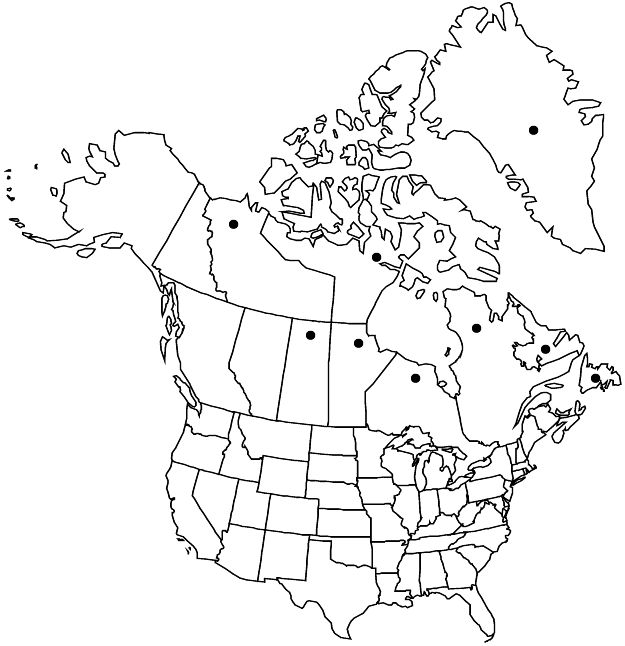Cerastium alpinum
Sp. Pl. 1: 438. 1753.
Plants perennial, mat-forming, rhizomatous. Stems prostrate or ascending, tomentose (very rarely subglabrous), hairs white, translucent, long, soft, flexuous, some usually also short and glandular; flowering shoots ascending, 5–20 cm; small axillary tufts of leaves usually absent; nonflowering shoots ± prostrate, to 6 cm. Leaves marcescent or not, sessile; blade obovate or ovate to elliptic-oblanceolate, elliptic, or lanceolate, usually 10–18 × 5–7 mm, apex obtuse, pubescence as on stems. Inflorescences open, (1–) 2–4-flowered cymes; bracts lanceolate, acute, margins narrow, scarious, glandular-pubescent. Pedicels straight but often becoming angled at base and curved at apex, slender, 5–30 mm, often elongating to 3 or 4 times as long as sepals, pubescence usually dense, hairs both long, flexuous, multicellular, and short, glandular, viscid. Flowers: sepals green, often violet-tipped, narrowly elliptic-lanceolate, 7.5–10 mm, margins ± narrow, apex acute to obtuse, densely pubescent, hairs both long, eglandular and short, glandular; petals 1–2 times as long as sepals, apex shallowly 2-fid; stamens 10; styles 5. Capsules cylindric, slightly curved, 12–16 mm, to 2 times as long as sepals; teeth 10, erect, margins convolute. Seeds dark-brown, 1–1.4 mm diam., acutely tuberculate; testa not inflated. 2n = 72, 108.
Distribution

Man., N.W.T., Nunavut, Ont., Que., Sask., Greenland, Canada, Europe (Iceland), Europe (Scandinavia)
Discussion
Subspecies 3+ (2 in the flora).
The Cerastium alpinum group of species is a difficult complex of intergrading taxa. E. Hultén (1956) considered this complex to be the result of worldwide introgression among the various taxa. Members of this group in North America include C. aleuticum, C. alpinum, C. arcticum, C. beeringianum, C. bialynickii, C. fischerianum, C. regelii, and C. terrae-novae. Cerastium alpinum itself is distinguished from all other members of the complex by its lanate pubescence, which consists of long, silvery, translucent, multicellular, flexuous, often tangled hairs; the more or less square base of the calyx; the convex margins of the sepals; and, in well-grown plants, the long, slender, divaricate pedicels.
In western North America, Cerastium alpinum is replaced by C. beeringianum, which has long, straight, strigose, somewhat fuscous hairs, usually smaller flowers, and smaller seeds. The two species intergrade in eastern Canada; intermediate specimens were named C. alpinum var. strigosum Hultén.
Cerastium arcticum differs from C. alpinum, with which it often grows, in its straight, somewhat fuscous hairs; calyx which is round at the base; long, narrowly lanceolate sepals; large, straight, broad capsules; and broad, obtuse cauline leaves. Like C. alpinum, it usually has large flowers with the petals much longer than the sepals.
Many infraspecific taxa have been named in Cerastium alpinum but in North America it is much less variable than elsewhere. Two forms can be recognized at either the varietal or subspecific level.
Selected References
None.
Key
| 1 | Leaf blades on flowering shoots narrowly elliptic or lance-elliptic to oblanceolate, apex ± acute, pubescence evenly distributed, not very dense; inflorescences usually (1-)2-4-flowered | Cerastium alpinum subsp. alpinum |
| 1 | Leaf blades on flowering shoots lance-elliptic to ovate or obovate, apex obtuse, pubescence a tuft of longer, silvery, ± tangled hairs at apex; inflorescences usually 1-flowered | Cerastium alpinum subsp. lanatum |
"-2timesaslongassepals" is not declared as a valid unit of measurement for this property."elongating" is not a number.